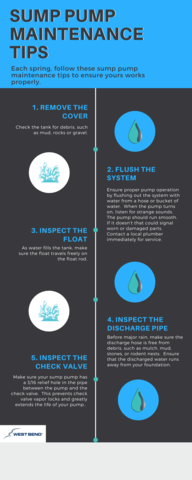With the large amount of snow melting in the next few weeks, March, April and May are typically heavy volume months for sump pump claims. Significant fluctuations in spring weather can result in water pooling and saturating soil. Spring months means "sump season". Here are some facts regarding water damage.
- Estimates indiciate 98% of basements in the U.S. will eventually experience water damage.
- The average insurance claim for water damage is $6,965
Unlike other appliances, a sump pump quietly does its job and you probably don't pay attention to it. It's usually found in your basement and its primary function is to keep your basement dry.
How a sump pump works?
A sump pump collects ground water in a sump tank, also known as a basin, crock, or pit. When the ground water fills the tank to a certain level, the float travels up a float rod and activates a switch causing the pump motor to turn on. The motor then removes the water from the tank and discharges it away from your house.
Types of sump pumps
1. Submersible. This type of sump pump is the most common and it’s installed during home construction. The pump is covered inside the tank.
2. Non-submersible (Pedestal). This type of pump consists of a motor and a hose. The motor is installed above the basement floor. The hose is connected to the motor and then routed into the sump tank. This pump is less expensive and can be installed in any home at any time.
Benefits of a sump pump
1. Prevents flooding. Heavy periods of rain can cause water to accumulate around the base of your foundation. A sump pump will prevent the water from entering and flooding your basement. In addition, if you experience a burst pipe in your basement, a floor drain may not be enough to eradicate the water. A sump pump may help push this water out, minimizing the amount of standing water.
2. Reduces mold growth. Standing water can lead to mold growth. Mold can be harmful to your health and your house. Keeping your basement dry can prevent growth.
3. Prevents dampness.
4. Prevents fires. Water entering your basement can cause appliances to short-circuit which could lead to an electrical fire.
5. Relatively inexpensive. Depending on where you live, Mother Nature can keep your pump running on a regular basis. For the protection that a sump pump provides your home, they are relatively inexpensive. Keep in mind that they may last 15-30 years, so replacement does not occur regularly.
If you decide to “do it yourself”, it’s estimated that a standard 1/3 hp sump pump can cost between $100 and $200. If you have one professionally installed by a plumber it could cost on average around $1,100.
The actual cost will depend on your location, the plumber you choose, and the pump options.
Maintenance tips
Each spring, follow these sump pump maintenance tips to ensure yours works properly.
1. Remove the cover. Check the tank for debris, such as mud, rocks, or gravel.
2. Flush the system. Ensure proper pump operation by flushing out the system with water from a hose or bucket of water. When the pump turns on, listen for strange sounds. The pump should run smooth. If it doesn’t that could signal worn or damaged parts. Contact a local plumber immediately for service.
3. Inspect the float. As water fills the tank, make sure the float travels freely on the float rod.
4. Inspect the discharge pipe. Before major rain, make sure the discharge hose is free from debris, such as mulch, mud, stones, or rodent nests. Ensure that the discharged water runs away from your foundation.
5. Inspect the check valve. Make sure your sump pump has a 3/16 relief hole in the pipe between the pump and the check valve. This prevents check valve vapor locks and greatly extends the life of your pump.
Give Modern Insurance a call to check if you're adequately covered.


Discussion
There are no comments yet.